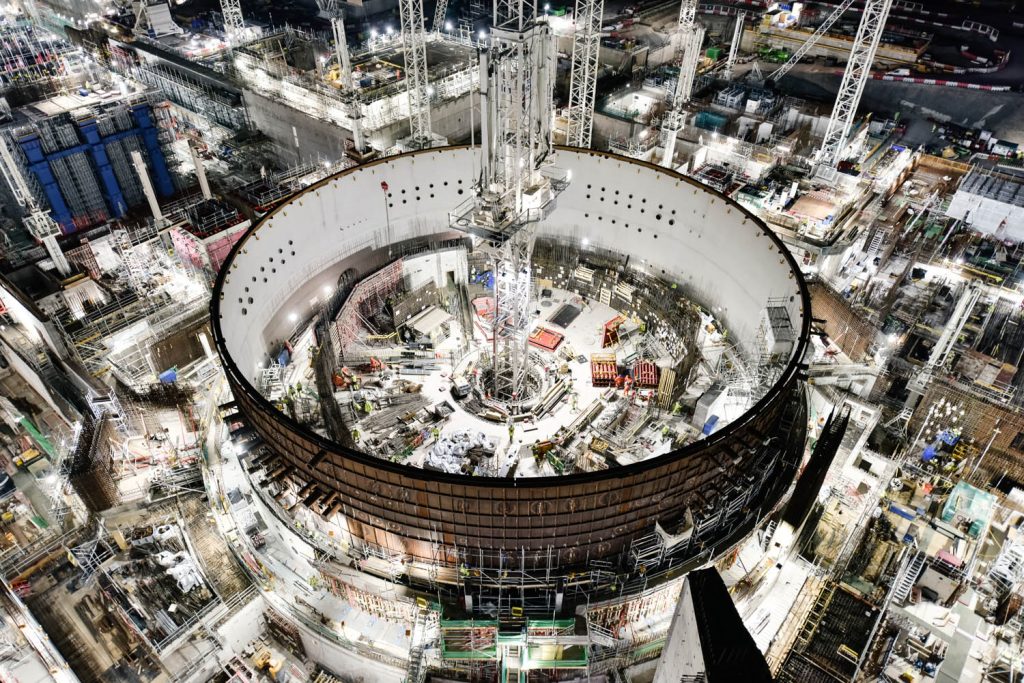Article #6 of 8 from AEC Magazine’s IFC Special Report
By Tim Davies, digital engineering manager, BYLOR Joint Venture (JV) – Hinkley Point C
Hinkley Point C (HPC) is the first new nuclear power station to be built in the UK in a generation. The Bylor Joint Venture (Laing O’Rourke and Bouygues Travaux Publics) is delivering the civil engineering contract using 3D, clashfree, buildable models.
We are proud that we have made Industry Foundation Classes (IFCs) business-asusual and that we have shown it is a highly capable standard for use across the whole Architectural Engineering and Construction (AEC) sector.
For us, IFC is not just something we are talking about, or trialling, or that gets issued as a nice-to-have alongside native models; it is the primary model data structure through which all our digital model workflows happen. If someone needs to view a model, it’s the IFC model everyone goes to – first time, every time.
To me, nothing quite indicates just how business-as-usual IFC is in Bylor like the fact that using IFC is so rarely questioned. Discussions are certainly not discouraged, but everyone understands and sees firsthand the benefits it brings.
Outsiders are often surprised to see the scale at which we use IFC, but this surprise is usually based on either misconceptions or a bad experience with IFC years ago.
Once we demonstrate how we use it, they quickly come around to our point of view. I’m delighted to present this case study on how IFC is helping Bylor deliver one of the largest civil engineering projects in the world.
From the very early days of the project, it was recognised by all that having a 3D, clashfree, buildable design was going to be crucial to delivering the civil engineering contract efficiently. The large supply chain would have meant design and construction information coming from a variety of businesses and many different platforms.

For us, IFC is not just something we are talking about, or trialling, or that gets issued as a nice-to-have alongside native models; it is the primary model data structure through which all our digital model workflows happen
While one approach could have been to mandate a single piece of software or platform for everyone, this goes against the principle of allowing people to choose the best tool for their job. Instead, we standardised on the data layer and the natural fit was the ISO standard for data in construction, IFC. Having a consistent data structure means we can federate models from many platforms in many platforms.
People
Our engineers love to use IFC because of the freedom it gives them. They can choose the best tool for the job from a large ecosystem of tools, regardless of vendor. This has caused a weird irony to emerge whereby we have the ability to use many more tools than most but, because IFC is the only model data structure we need to support, we get away with using fewer tools.
For the younger engineers joining the construction industry through Bylor, there is no question about whether IFC works or not, because it just does. They often struggle to understand how a construction project could operate without IFC!
When presented with a model that is not an IFC model, their reflex is to ask for it in IFC, and failing that, to convert it to IFC themselves. After a period of time, having a non-IFC model starts to feel distinctly unnatural and restrictive. Why use anything else when IFC is so widely supported?
Using an open standard like IFC brings the added benefit that we know our model data will never be rendered inaccessible by a software vendor. With proprietary formats, there’s always the nagging feeling of not really knowing how your data is being stored or whether it will still be supported in X years’ time.
Technology
The stability of IFC as an ISO standard has given us the confidence to invest in tooling, infrastructure, and workflows knowing we are in total control of the data. We don’t worry about being tied to a particular vendor or dealing with uncertain future licensing costs. Because of this, Bylor has developed a world-leading suite of digital tools, all based around IFC. From detecting voids in concrete models for health and safety purposes, adding additional properties, optimising the internal IFC structure, to stripping models of security sensitive data, IFC serves all our needs.
One example is a tool we developed to detect and classify concrete surfaces based on the Civil Engineering Standard Method of Measurement (CESMM), saving thousands of hours of time that might otherwise have been spent manually analysing and calling off from models. While the core logic of this could have been implemented in any tool, by basing it around IFC, the tool is so much more flexible than it would have been otherwise.
Furthermore, the lessons people have learned about IFC by developing one tool are being directly transferred to other tools that use IFC. There has been no need for us learn a dozen different APIs just to be able to handle models authored in different software. Knowledge of IFC really does give developers a superpower in the construction industry.
These IFC supporting tools create longterm benefits because they can continue to be used into the future with minimal maintenance, and on future nuclear projects such as Sizewell C.
Open source and innovation
The open nature of IFC has meant that the ecosystem of open source AEC tools is rapidly growing. A great example of an open source tool we use is BlenderBIM (see Native OpenBIM, and the rise of open source in AEC). It has quickly become our visualisation tool of choice and we are continuing to investigate its native IFC editing capabilities.
Because we are standardised on IFC, we can almost instantly take advantage of these new innovations. There is no hanging around having to coordinate mass software upgrades. We can be dynamic and easily deploy new software, and keep using the best tools for the job even after the project has started.
Is IFC perfect? No. We still find that export and import implementations can be inconsistent, but all are steadily improving. If we do have a major technical problem, the open nature of IFC means we can much more easily identify the root cause and come up with creative solutions.
Closing thoughts
My advice is to get involved with buildingSMART to give feedback and influence the direction of IFC so that it works even better for everyone. If you are unfamiliar with IFC, I recommend learning about it as soon as you can. A great starting point is Emma Hooper’s excellent beginner’s guide to IFC (see IFC: what is it and why is it needed). You will be able to use the experience and knowledge you accrue again and again.
Invest some time and focus on IFC, and once you get used to the freedom that using IFC brings, you won’t want to go back to using anything else.
Click here for more information about buildingSmart UK & Ireland.
This article is part of AEC Magazine’s
IFC Special Report – Enabling interoperability in the AEC industry.
To read the other articles in this report click on the links below.
Industry convergence
From sustainability to new business models, and from wellness to emerging technologies, IFC can be a force for good, driving the AEC industry to new levels of achievement
Inside buildingSMART
What is buildingSMART and what can it offer industry practitioners?
IFC: what is it and why is it needed
Emma Hooper, Associate Director and Head of R&D at Bond Bryan Digital, provides a useful overview of the IFC data model specification
IFC for Infrastructure
Perhaps the most significant update to the IFC standard is the inclusion of extensions for infrastructure entities in IFC 4.3
Native OpenBIM, and the rise of open source in AEC
OpenBIM can deliver on the promise of a digital world for the built environment where information and data are truly valued
Tackling the Gen Zero Project
The UK Department for Education’s Gen Zero project showcases how IFC can be used as the underlying data standard for a large, complex project, from start to finish
buildingSMART certification
By Phil Read, program lead at bSUKI and managing director, Man and Machine






